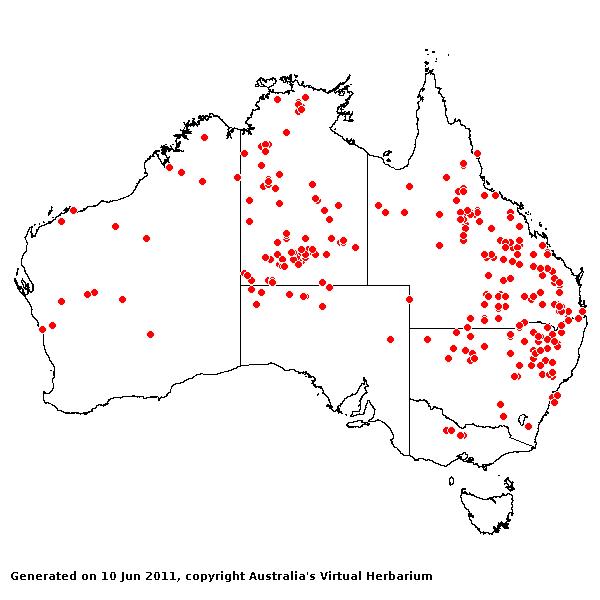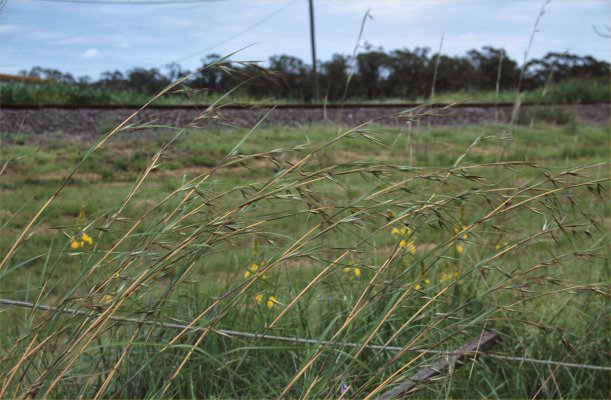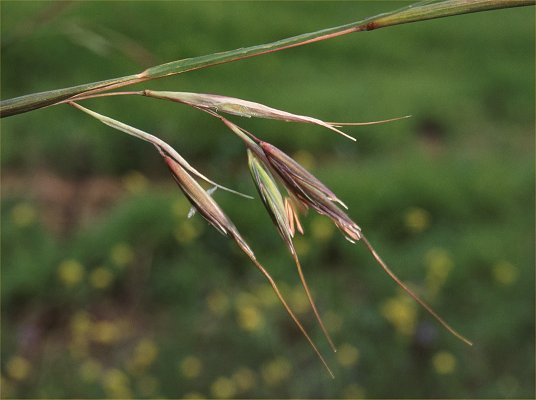Themeda avenacea (F. Muell.)
Dur.& Jacks. Census New South Wales Pl. 15 (1916).
Classification. (GPWG 2001) : Subfamily Panicoideae. Andropogoneae.
Basionym and/or
Replacement Name: Anthistiria
avenacea F. Muell., Fragm. 5: 206 (1866).
Type of Basionym or
Protologue Information: Australia, Peak Downs: Mueller (K iso).
Key references
(books and floras): [1878] G.Bentham, Flora Australiensis 7 (543 as Anthistiria
avenacea), [1952] C.A.Gardner, Flora of Western Australia 1 Gramineae
(344), [1981] M.Lazarides in J.Jessop (ed)., Flora of Central Australia
(493), [2002] D.Sharp & B.K.Simon, AusGrass, Grasses of Australia,
[2006] J.Jessop, G.R.M.Dashorst, F.M.James, Grasses of South Australia
(533), [2008] S.W.L.Jacobs, R.D.B.Walley & D.J.B.Wheeler, Grasses of New
South Wales (38).
Illustrations:
[2006] J.Jessop, G.R.M.Dashorst, F.M.James, Grasses of South Australia (534, fig. 455), [2008] S.W.L.Jacobs,
R.D.B.Whalley & D.J.B.Wheeler, Grasses of New South Wales, 4th edn
(3823).
Habit.
Perennial. Culms erect, stature robust to moderate, 100–200 cm tall, 2–4 mm
diam., 2–3 -noded. Mid-culm nodes glabrous or pubescent. Ligule an eciliate
membrane, 2–7 mm long. Leaf-blades conduplicate, 15–100 cm long, 1–1.5 mm wide.
Leaf-blade surface scaberulous.
Inflorescence.
Inflorescence compound, of pedicelled spikelet clusters. Rhachis fragile at the
nodes.
Spikelets.
Spikelets sessile, 1 in the cluster. Companion spikelets pedicelled, 1 in the
cluster or 2 in the cluster. Basal sterile spikelets well-developed, 4 in
number. Companion spikelets developed, containing empty lemmas, symmetrical or
asymmetrical, 20–30 mm long. Fertile spikelets 2-flowered, the lower floret
barren (rarely male), the upper fertile, comprising 1 basal sterile florets,
comprising 1 fertile floret(s), without rachilla extension, oblong, terete,
13–17 mm long.
Glumes. Glumes
dissimilar, firmer than fertile lemma. Lower glume oblong, cartilaginous, much
thinner on margins, without keels, 11 -nerved. Lower glume surface indumented.
Upper glume oblong, cartilaginous, 3 -nerved. Upper glume surface indumented. Florets.
Basal sterile florets 1, barren, without significant palea. Lemma of lower
sterile floret hyaline, 1 -nerved.
Fertile lemma without
keel, 1 -nerved. Lemma apex entire, awned, 1 -awned. Median (principal) awn
apical, 40–100 mm long overall, with a twisted column. Palea absent. Anthers 3.
Continental
Distribution: Australasia.
Australian
Distribution: Western Australia, Northern Territory, South Australia,
Queensland, New South Wales, Victoria.
Western Australia:
Dampier. Keartland, Carnegie, Fortescue, Ashburton, Austin. Northern
Territory: Victoria River, Central Australia North, Central Australia
South. South Australia: North-western. Queensland: Burke,
Burnett, Cook, Darling Downs, Leichhardt, Maranoa, Mitchell, North Kennedy,
Port Curtis, South Kennedy, Warrego. New South Wales: North-Western
Slopes, Central-Western Slopes, North-Western Plains, North Far Western Plains.
Victoria: Riverina.
Notes.
An endemic species growing in the drier regions of all mainland states. Flowers
Nov.--Sept.







